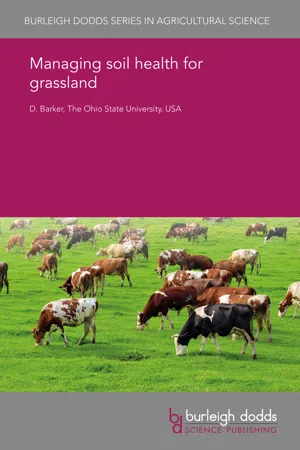Managing soil health for grassland
About this book
Soil health is a holistic concept that includes all the processes affecting the ability of soil to provide the ecosystem services we require from grassland. The primary 'service' provided by grassland is forage for livestock, but additional secondary 'services' can include benefits such as environmental protection, protection of valued fauna and flora, aesthetic qualities and improved soil health. We have no single parameter for measuring soil health, but we rely on a number of indicators that are still being refined and developed for practical use. Furthermore, we invariably do not control those indicators directly, but rely on indirect mechanisms to improve soil health. This chapter considers some of the major issues and strategies for managing grassland soil, with a specific focus on management of soil fertility and fertilizer input.
Frequently asked questions
- Essential is ideal for learners and professionals who enjoy exploring a wide range of subjects. Access the Essential Library with 800,000+ trusted titles and best-sellers across business, personal growth, and the humanities. Includes unlimited reading time and Standard Read Aloud voice.
- Complete: Perfect for advanced learners and researchers needing full, unrestricted access. Unlock 1.4M+ books across hundreds of subjects, including academic and specialized titles. The Complete Plan also includes advanced features like Premium Read Aloud and Research Assistant.
Please note we cannot support devices running on iOS 13 and Android 7 or earlier. Learn more about using the app.
Information
Table of contents
- 1 Introduction
- 2 Measurement of soil health
- 3 Managing soil health for grassland production
- 4 Fertilization for carbon (C) sequestration
- 5 Earthworms as an indicator of soil health
- 6 Soil nutrient status
- 7 Trace elements and heavy metals
- 8 Conclusion
- 9 Future trends
- 10 Where to look for further information
- 11 References
